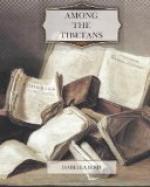Dr. Marx left on the third day, after we had visited the monastery of Hemis, the richest in Ladak, holding large landed property and possessing much metallic wealth, including a chod-ten of silver and gold, thirty feet high, in one of its many halls, approached by gold-plated silver steps and incrusted with precious stones; there is also much fine work in brass and bronze. Hemis abounds in decorated buildings most picturesquely placed, it has three hundred lamas, and is regarded as ‘the sight’ of Ladak.
At Upschi, after a day’s march over blazing gravel, I left the rushing olive-green Indus, which I had followed from the bridge of Khalsi, where a turbulent torrent, the Upshi water, joins it, descending through a gorge so narrow that the track, which at all times is blasted on the face of the precipice, is occasionally scaffolded. A very extensive rock-slip had carried away the path and rendered several fords necessary, and before I reached it rumour was busy with the peril. It was true that the day before several mules had been carried away and drowned, that many loads had been sacrificed, and that one native traveller had lost his life. So I started my caravan at daybreak, to get the water at its lowest, and ascended the gorge, which is an absolutely verdureless rift in mountains of most brilliant and fantastic stratification. At the first ford Mando was carried down the river for a short distance. The second was deep and strong, and a caravan of valuable goods had been there for two days, afraid to risk the crossing. My Lahulis, who always showed a great lack of stamina, sat down, sobbing and beating their breasts. Their sole wealth, they said, was in their baggage animals, and the river was ‘wicked,’ and ‘a demon’ lived in it who paralysed the horses’ legs. Much experience of Orientals and of travel has taught me to surmount difficulties in my own way, so, beckoning to two men from the opposite side, who came over shakily with linked arms, I took the two strong ropes which I always carry on my saddle, and roped these men together and to Gyalpo’s halter with one, and lashed Mando and the guide together with the other, giving them the stout thongs behind the saddle to hold on to, and in this compact mass we stood the strong rush of the river safely, the paralysing chill of its icy waters being a far more obvious peril. All the baggage animals were brought over in the same way, and the Lahulis praised their gods.
At Gya, a wild hamlet, the last in Ladak proper, I met a working naturalist whom I had seen twice before, and ‘forgathered’ with him much of the way. Eleven days of solitary desert succeeded. The reader has probably understood that no part of the Indus, Shayok, and Nubra valleys, which make up most of the province of Ladak, is less than 9,500 feet in altitude, and that the remainder is composed of precipitous mountains with glaciers and snowfields, ranging from 18,000 to 25,000 feet, and that the villages are built mainly on alluvial soil where possibilities of irrigation exist. But Rupchu has peculiarities of its own.




